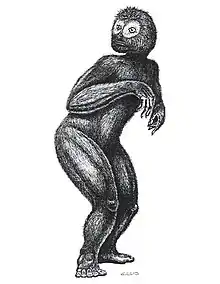Skunk ape
The Skunk ape is an ape-like creature purported to inhabit the forests and swamps of some southeastern U.S. states,[1] with reports from Florida being most common. It is named for its appearance and unpleasant odor. The skunk ape is reported to resemble the Sasquatch of the Pacific Northwest, but is typically shorter in comparison, has long patches of hair on the shoulders and arms similar to an orangutan, and is often described as a mottled rusty-red color as opposed to the Sasquatch's brown or black coloration. Some reports also describe the creature as having pale coloration around its eyes or face, similar to a gibbon.

History
The skunk ape has been a part of Florida, Georgia, and Alabama folklore since the settler period.[2] Seminole myth speaks of a similar foul-smelling, physically powerful, and secretive creature called Esti Capcaki, a name which roughly translates as "cannibal giant".[3] One of the first reports of a large simian creature in Florida came from 1818, when a report from what is now Apalachicola, Florida, spoke of a man-sized monkey or ape raiding food stores and stalking fishermen.[4]
Reports of the skunk ape were particularly common in the 1960s and 1970s. In 1974, sightings of a large, foul-smelling, hairy, ape-like creature, which ran upright on two legs were reported in suburban neighborhoods of Dade County, Florida. In 1977, after a rash of sightings by dozens of eyewitnesses across several Florida counties, a failed-to-pass bill was proposed to the state legislature to make it illegal to "take, possess, harm or molest anthropoids or humanoid animals".[5]
Skeptical investigator Joe Nickell has written that some of the reports may represent sightings of the black bear (Ursus americanus) and it is likely that other sightings are hoaxes or misidentification of wildlife.[6] The United States National Park Service considers the skunk ape to be a hoax.[7]
Names
Other names for the creature include swamp cabbage man, swamp ape, stink ape, Florida Bigfoot, Louisiana Bigfoot, myakka ape, swampsquatch, Swampfoot and myakka skunk ape.
In folklore and popular culture
The skunk ape has been widely adopted across South and Central Florida as a mascot for the Florida wilderness and rural culture. The cryptid has appeared in numerous roadside businesses and attractions, television commercials, and signs.[8] During the COVID-19 pandemic, several Florida businesses have used the Skunk Ape's reported foul smell giving incentive to remain at a distance and evasive nature to promote social distancing.[9]
See also
References
- Lennon, Vince (2003-10-22). "Is a Skunk Ape Loose in Campbell County?". WATE 6 News. WorldNow and WATE. Archived from the original on 2007-01-01. Retrieved 2006-12-23.
- Stromberg, Joseph. "On the Trail of Florida's Bigfoot—the Skunk Ape". Smithsonian Magazine. Retrieved 19 May 2020.
- Childress, David (2018). Bigfoot nation : the history of sasquatch in North America. Adventures Unlimited Press. p. 208. ISBN 9781939149961.
- Robinson, Robert (2016). Legend Tripping (1st ed.). Adventures Unlimited Press. ISBN 9781939149695.
- Thursday, The Immokalee Bulletin is published every (1 November 2018). "Area was famous for close encounters with Cryptid 'Skunk Apes'". Immokalee Bulletin. Archived from the original on 2020-09-17.
- Nickell, Joe. "Tracking Florida's Skunk Ape". Archived from the original on 2014-07-25. Retrieved 2014-07-12.
- "The abominable swampman". BBC News. 1998-03-06. Retrieved 2006-12-23.
- "Official Skunk Ape Headquarters". Everglades Adventure Tours. Retrieved 16 September 2020.
- Winningham, Cathleigh (19 May 2020). "Skunk Ape: Here's how Gatorland will enforce social distancing". WKMG. Click Orlando.
Further reading
- Stromberg, Joseph (March 6, 2014). "On the Trail of Florida's Bigfoot—the Skunk Ape". Smithsonian. Retrieved 18 August 2016.